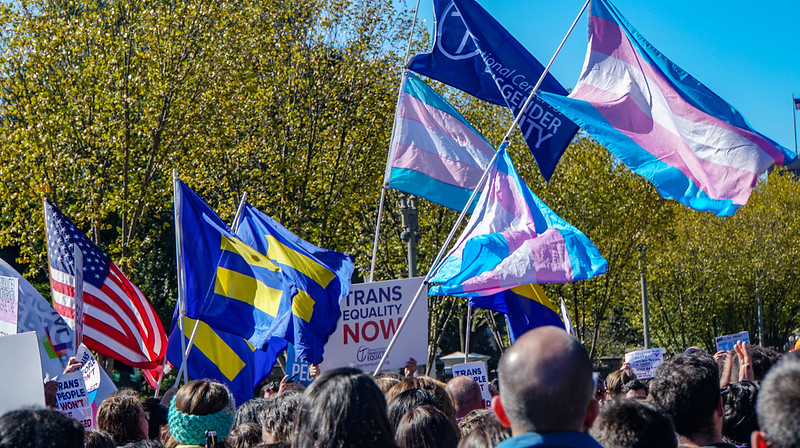10.1 Chapter Overview and Learning Objectives
10.1.1 Learning Objectives
- Differentiate among attitudes associated with sex and sexuality.
- Describe sex education issues in the United States.
- Discuss theoretical perspectives on sex and sexuality.
- Understand sexual scripts and inequalities they can produce.
- Examine experiences of discrimination.

Figure 10.1. Photo taken during a protest in October of 2018, historical attacks on LGBTQIA+ continue currently in many states across the country.
“Don’t say gay” ideologies and regulations are the most recent controversy in a long-standing debate about sexual and gender equality. The Parental Rights in Education Act was passed into law in 2022 in Florida (The Florida Senate. 2022). This law prohibits any teacher from teaching about sexual identity or gender identity to kids in kindergarten through third grade, but also in any grade if it is considered in any way “age or developmentally inappropriate.” It also requires teachers to grant parents full access to their students’ education and health records. By examining this issue through a sociological perspective, we can start to see how this policy may have greater consequences, impacting health and resources.On the surface, permitting parents access to records and engaging in age-appropriate conversations around sexuality and gender identity may not seem like bad policy.
But here is the issue with this law: if a child “comes out” to a teacher or school official, then that information cannot be withheld from parents, which we know historically can be dangerous for both mental and physical health as LGBTQIA+ youth have one of the highest risk rates of mental health issues (Trevor Project 2022, NEA 2022). The bill states that there may be procedures to protect a student’s information if a “reasonably prudent person would believe that disclosure would result in abuse, abandonment, or neglect,” but the language is unclear at best. Also, the “Don’t say gay” label to this bill is based on the idea that saying the word gay, stating that someone is transgender or nonbinary, or acknowleging nonheterosexual relationships within a classroom can now be considered “teaching students about sexual orientation or gender identity.” That is problematic given that parents can file complaints and sue the school if they think that their child has been exposed to this information. This is a direct attack and attempt to silence the LGBTQIA+ community by forcing many to hide their identities for fear of retribution from parents, school districts, and the state.
This chapter will look at the intersection of identities with social institutions such as education, as well as how sexuality fits into society, both in micro and macro terms. We will also look at sex and behavior, including gendered differences and behaviors around the world.
10.1.2 Licenses and Attributions for Chapter Overview and Learngin Objectives
“Overview” by Heidi Esbensen is licensed under CC BY 4.0.
Figure 10.1. “2018.10.22 We Won’t Be Erased – Rally for Trans Rights, Washington, DC USA 06815” by Ted Eytan is licensed under CC BY-SA 2.0.
